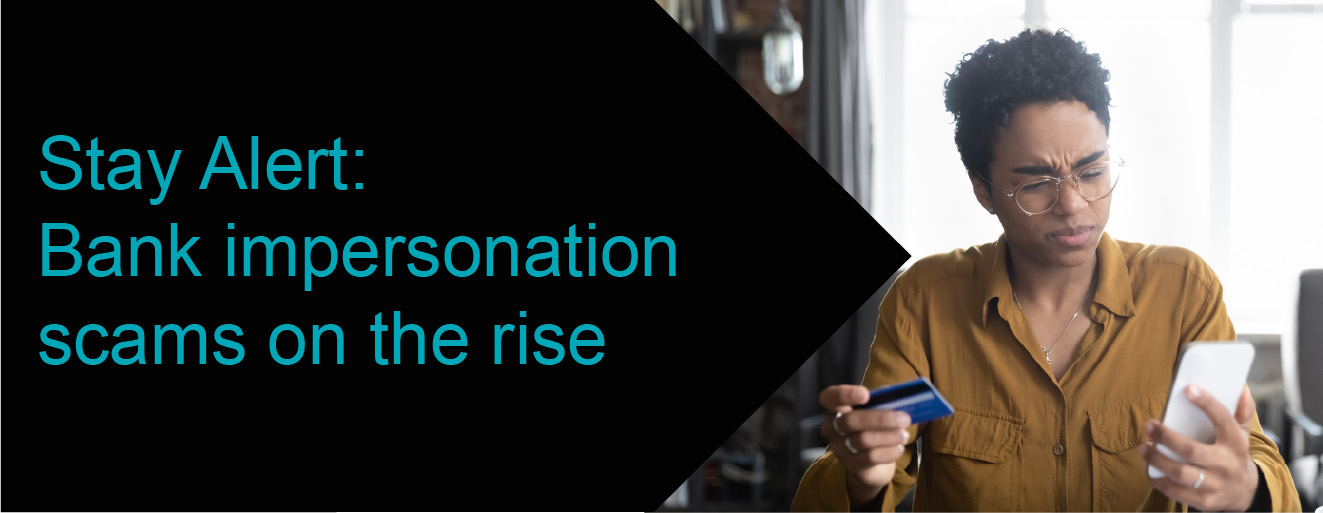Bank Impersonation Scams

We'd like to draw your attention to the increasing number of bank impersonation scams in Australia, which have been growing in sophistication and complexity.
According to ACCC’s Scamwatch, there were over 14,600 bank impersonation scams reported in 2022, causing losses over $20 million. Total losses to phone and text scams increased considerably in the past year, with losses exceeding $169 million.1
What is a bank impersonation scam?
Bank impersonation scams occur when a scammer impersonates a bank or financial institution to trick their victims into making payments to a fraudulent account. The scammer may make the phone call seem like it is coming from the bank's legitimate phone number or send a SMS that appears in the same thread as genuine bank messages.
How to identify a bank impersonation scam1
It’s important to stay vigilant and informed about the different scams to spot warning signs and avoid becoming a victim. Be on the lookout if:
- There is a sense of urgency or threat to the message – “your bank account has been accessed”, “your bank account has been locked” “a payment has been made from your account. If this was not you, please call (phone number)”.
- The message looks different to other messages in the SMS thread, such as different wording or phrases used.
- The message contains a suspicious looking link. Never click on suspicious links.
- The SMS has a telephone number to call – always find your bank’s phone number independently.
- The caller tells you to transfer money to a different account to ‘keep it safe’ or for ‘further investigation’. This is not standard procedures for a bank. It is a SCAM.
How to protect yourself from this type of scam:
Follow our top tips below to avoid falling a victim and to ensure that your personal information and finances remain secure.
- A genuine call from your Bank or our fraud department will only ever ask you to confirm the last four digits of the Visa Card affected.
- Do not trust the information provided by the scammer. Any information provided is likely to be false like their contact number and designed to create an impression of believability.
- Always know who you are dealing with. Avoid responding to unsolicited and unexpected contact. You have the right to ask the caller questions to assess the legitimacy of the call. Hang up if you are uncomfortable with the caller.
- Do not provide your banking details to anyone over the phone. We will NEVER ask for your contact details over SMS or email. If possible, collect the caller’s name, phone number and their position and then call us on 1300 36 2000 immediately.
- Again, never click on URL links or open attachments in suspicious emails or SMS.
- Just because your name is in the SMS or email, it does not mean it is contact from the Bank. Always double-check directly with us, your Bank.
- Always go to our Internet Banking directly, do not use the links provided on the messages.
Here are some additional tips from Scamwatch to help protect yourself from the scams1:
Stop – take your time before giving money or personal information.
Think – ask yourself if the message or call could be fake?
Protect – act quickly if something feels wrong. Contact us on 1300 36 2000 and report scams to Scamwatch.
We take the security of our Members very seriously. If you're worried or you’ve noticed a suspicious transaction, call us immediately on 1300 36 2000.
To know more about types of scams, click here.
1. Source: "Bank impersonation scams robbing Australians of their life savings" https://www.scamwatch.gov.au/news-alerts/bank-impersonation-scams-robbing-australians-of-their-life-savings, 30 Mar 2023.





